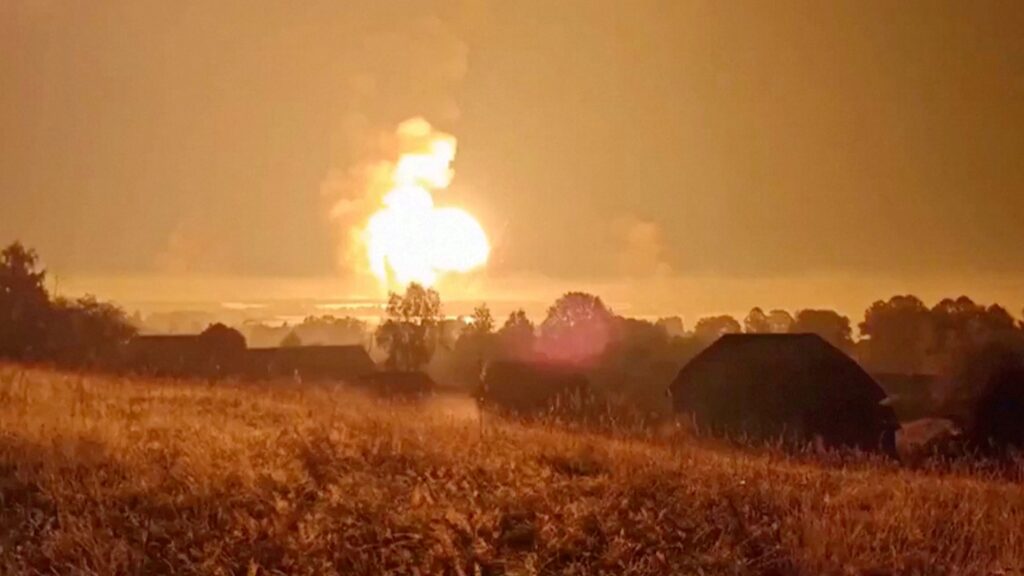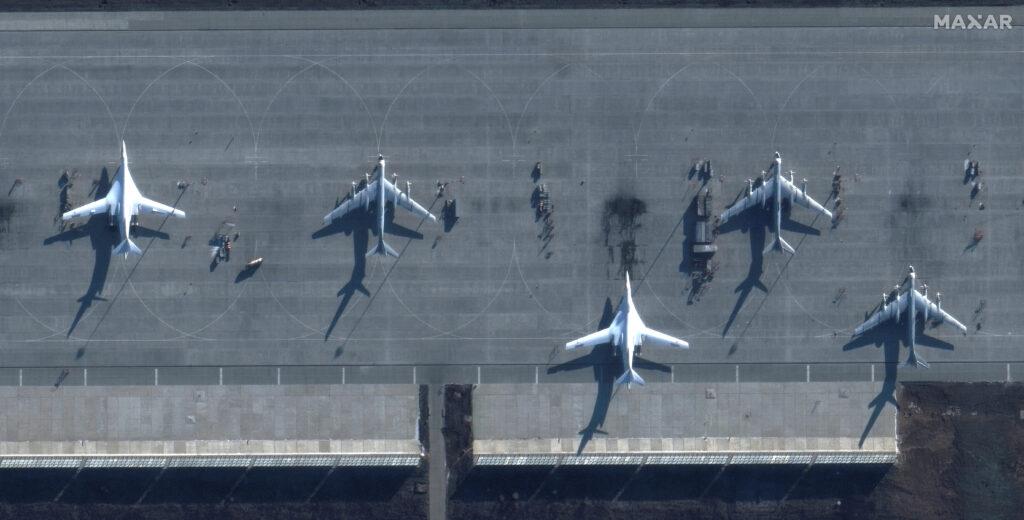With major military, strategic, and diplomatic ramifications, the situation in the Russia-Ukraine war is complicated and multifaceted, especially considering Ukraine’s massive drone attack on Russian airbases on June 1, 2025, code-named “Operation Spider’s Web.” A thorough summary based on the information at hand is provided below:

Military Impact of Ukraine’s Attack on Russian Airbases
• Scale and Targets: Four important Russian airbases were the focus of a coordinated drone attack by Ukraine’s Security Service (SBU): Belaya (Irkutsk region), Olenya (Murmansk region), Diaghilevo (Ryazan region), and Ivanovo. These bases, which were thousands of kilometers away from Ukraine, were home to A-50 early warning aircraft and strategic bombers that were essential to Russia’s long-range strike capabilities. These included nuclear-capable Tu-95 “Bear,” Tu-22M3 “Backfire,” and Tu-160 “Blackjack” aircraft.
• Reported Damage: According to Ukrainian sources, the attack destroyed or damaged more than 40 aircraft, or 34 percent of Russia’s strategic cruise missile carriers. The estimated damages range from $2 billion to $7 billion. According to unverified reports, two Tu-160s were reportedly struck at Belaya, and at least 13 aircraft were destroyed. Three Tu-95s and one Tu-22M3 were confirmed damaged at Belaya by satellite imagery, and one more Tu-95 may have been damaged.
• Operational Specifics: 117 first-person-view (FPV) drones were smuggled into Russia, concealed on trucks in wooden sheds, and launched remotely close to the airbases. This creative strategy demonstrated sophisticated logistical planning over 18 months, enabling Ukraine to strike deep into Russian territory while evading Russian air defenses.
• Russian Reaction: The Russian Defense Ministry acknowledged that multiple aircraft caught fire in Murmansk and Irkutsk but asserted that other attacks were repulsed. The ministry confirmed attacks on five regions: Ryazan, Amur, Ivanovo, Irkutsk, and Murmansk. Some “participants” were arrested, but no casualties were reported. The attack was referred to by Russian military bloggers as a “black day” for Russian aviation, pointing out weaknesses brought about by openly stored aircraft and undefended hangars.

Strategic Consequences
• Weakening Russian Capabilities: Cruise missiles against Ukraine are launched by the targeted bombers. Since Russia is unable to produce new Tu-95s, Tu-22M3, or Tu-160s and must instead rely on stockpiles from the Soviet era, their destruction or damage could drastically limit Russia’s ability to launch long-range strikes. Because of Russia’s strained military-industrial complex, repairs are probably going to be difficult.
• Symbolic Blow: These bombers stand for Russia’s strategic invulnerability and nuclear power. Their susceptibility to inexpensive Ukrainian drones damages Russia’s reputation as a military powerhouse and gives Ukraine a major propaganda win.
• Ukrainian Innovation: By employing comparatively low-cost technology to cause disproportionate harm, the operation demonstrates Ukraine’s developing proficiency in drone warfare. This might make Western armies reevaluate how susceptible they are to similar low-cost, high-impact attacks.
Russian Retaliation
• Escalation: On the evening of May 31, 2025, just hours before the Ukrainian attack, Russia launched its biggest aerial assault of the conflict, scattering seven missiles and 472 drones throughout Ukraine. While 385 of these were intercepted by Ukraine’s air force, strikes struck 18 targets, leaving at least five civilians dead and others injured. Ukraine’s land forces commander, Maj. Gen. Mykhailo Drapatyi, resigned after a Russian missile strike on a military training facility in Ukraine killed 12 soldiers and injured over 60 others.
• Other Events: Two bridges collapsed in the Bryansk region of Russia at the same time, and one of them killed seven people when a passenger train derailed. Such occurrences point to continued Ukrainian attempts to obstruct Russian logistics, even though no group took credit.
The Diplomatic Context
• Istanbul Peace Talks: The attacks took place as Turkey was getting ready to host a second round of direct peace negotiations in Istanbul on June 2, 2025. Under the direction of Defense Minister Rustem Umerov, Ukraine’s delegation sought to demand a total halt to hostilities as well as the release of prisoners and kidnapped children. There were questions about Russia’s commitment because the country, under the leadership of Vladimir Medinsky, had not disclosed its peace terms beforehand. Both parties’ escalation points to an effort to fortify their negotiating stances.
• U.S. Involvement: According to reports, the White House was not aware of Ukraine’s attack, and President Donald Trump has put pressure on both sides to find a speedy solution. Expectations for a breakthrough are still low, though, as Russia and Ukraine continue to insist on their fundamental demands.
Situation on the Frontlines Right Now
• Russian Advances: The village of Oleksiivka in Sumy has been taken by Russian forces, who are concentrating their offensive efforts on Pokrovsk, Toretsk, and Lyman in Donetsk as well as the border region of Sumy. Ukraine struggles to defend against Russian drone and missile attacks and lacks sufficient manpower.
• Ukrainian Resilience: As evidenced by the airbase attacks, Ukraine has maintained some frontline positions and is still able to innovate tactically in spite of being outgunned. President Zelenskyy stressed that by demonstrating Ukraine’s military prowess, such operations give it a stronger negotiating position.
More General Context
• Russian Vulnerabilities: Military bloggers criticized Russia’s leadership for their lack of fortified infrastructure and complacency after the attack revealed the country’s inability to safeguard vital assets. Although there has been no reported official response from President Vladimir Putin, some hardliners have called for nuclear retaliation.
• Western Implications: The operation highlights how warfare is changing and how inexpensive drones can endanger costly assets. According to analysts, the U.S. and other Western militaries must fix comparable weaknesses in their own defenses.
In conclusion
Russia’s strategic aviation capabilities were severely damaged by Ukraine’s “Operation Spider’s Web” on June 1, 2025, which also increased Ukraine’s diplomatic clout and morale in advance of peace negotiations. The war is still fierce, though, as evidenced by Russia’s massive retaliatory drone and missile strikes as well as continuous frontline offensives. Since both sides continue to place a higher priority on military gains to bolster their positions, it is unlikely that the Istanbul talks will produce results right away. The course of the conflict hinges on whether these well-publicized attacks spark a more severe Russian reaction or give Ukraine a sustained boost.
Note: Due to a lack of independent confirmation, some claims—most notably the precise number of aircraft destroyed—remain unverified. The extent of the damage may become clearer with satellite imagery and additional reporting.
Official statements from the Russian Defense Ministry did not specifically describe Russia’s immediate retaliatory actions after Ukraine launched a massive drone attack on Russian airbases on June 1, 2025, code-named “Operation Spider’s Web,” which reportedly destroyed or damaged over 40 Russian aircraft, including strategic bombers. However, the following summarizes Russia’s likely and reported responses based on the information that is currently available and trends of Russian responses to earlier Ukrainian strikes:
Verified Russian Activities
- Official Acknowledgment: A number of aircraft caught fire in Murmansk and Irkutsk, but other attacks were repelled, according to Russia’s Defense Ministry, which confirmed Ukrainian drone attacks on five regions: Murmansk, Irkutsk, Ivanovo, Ryazan, and Amur. The ministry called the strikes a “terrorist attack” and mentioned that some “participants” were arrested, implying that there were attempts to stop Ukrainian agents in Russia.
- Preceding Escalation: On May 31, 2025, just hours before Ukraine attacked, Russia launched its biggest aerial assault of the conflict, launching seven missiles and 472 drones across Ukraine, targeting 18 locations, and killing at least five civilians. This implies that Russia was already in an escalating posture, which the subsequent strike by Ukraine may have exacerbated.
- Missile Strike on Ukrainian Training Facility: Russia launched a missile strike on a Ukrainian military training facility the same day as the Ukrainian drone attack, leaving 12 soldiers dead and more than 60 injured. This attack, which caused Maj. Gen. Mykhailo Drapatyi, Ukraine’s land forces commander, to resign, was probably a component of Russia’s ongoing offensive, but it could also have been seen as a direct reaction to Ukrainian actions.
Unverified Reports about Retaliatory Strikes
• X Claims: According to a number of posts on X dated June 2, 2025, Russia retaliated by launching missile strikes that destroyed seven Ukrainian airbases in western Ukraine. The strikes targeted aircraft, including F-16s, MiG-29s, Su-27s, and Mirage 2000s. One of these posts reads, “Moscow’s message: Strike us and face the fire,” and characterizes the strikes as a direct reaction to Ukraine’s drone attack. These assertions, however, should be regarded as inconclusive because they have not been independently verified by reliable sources.
• Russian Blogger Reactions: Roman Alekhin and other pro-Russian military bloggers advocated for a harsh response, with some citing the American retaliation in Pearl Harbor as an example. They also conjectured that a nuclear escalation might be necessary. However, such drastic measures were not confirmed by any official Russian statements.
More General Context and Probable Reactions
• Internal Measures: Given the complexity of Ukraine’s drone smuggling strategies, the detention of those involved in the Ukrainian operation suggests Russia is stepping up internal security measures to stop additional infiltrations.
• Historical Pattern: Russia has regularly escalated its drone and missile attacks on Ukrainian cities and infrastructure in retaliation for Ukrainian strikes. For instance, Russia launched more than 900 drones in three days to target Kyiv and other areas in response to Ukrainian drone attacks on Moscow in May 2025. Given the magnitude of the June 1 attack on Ukraine, Russia most likely intensified or continued its aerial bombardment campaign, targeting Ukrainian military and civilian targets in an effort to disrupt logistics and demoralize the populace.
• Diplomatic Posturing: The Kremlin may use the Ukrainian attack as a pretext to postpone or impose more stringent conditions in the June 2, 2025, Istanbul peace talks, according to Russia’s Defense Ministry, which accused Ukraine of attempting to “disrupt” peace efforts.
Limitations on Russia’s Reaction
- Damaged Capabilities: If strategic bombers, which are necessary for launching cruise missiles, are lost, Russia might not be able to launch a quick, comprehensive aerial response. Repairs for the Tu-95, Tu-22M3, and Tu-160 aircraft may take a long time because of Russia’s limited military-industrial capacity.
- Political Considerations: Given the upcoming peace talks and US President Donald Trump’s push for a ceasefire, Russia may temper its retaliation to avoid bothering international mediators like Turkey or provoking additional Western sanctions, which Trump has threatened to intensify.
In conclusion
Verified sources do not fully detail specific retaliatory actions beyond the preemptive May 31 drone and missile barrage and the strike on a Ukrainian training facility, even though Russia’s Defense Ministry confirmed the Ukrainian drone attack and reported fires at airbases. There is no evidence to support the unverified claims on X that Russia targeted seven Ukrainian airbases. Russia probably intensified its drone and missile attacks on Ukrainian targets in accordance with its previous actions, and it might use the assault to defend more severe conditions in peace negotiations or additional internal crackdowns. The complete extent of Russia’s retaliation as of June 2, 2025, is hard to confirm due to the lack of an official statement from President Vladimir Putin and the absence of credible reports on additional strikes. Continuous observation of reliable sources is required for the most recent advancements.



